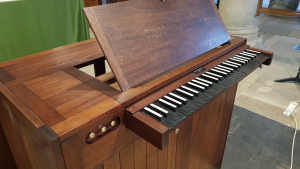The Main Organ

There are records of an organ on a west gallery in the church as early as the 16th century. This was destroyed by Puritan enthusiasts in the 1578 Visitation, but ‘organ pypes’ were back by 1657 and perhaps much earlier.
In 1702 a new organ was commissioned and built on the west gallery by ‘Father’ Smith. Repairs and additions followed in 1790, 1800–05, 1824 and 1846. The organ was moved in 1852 to the Bellingham Chapel at the East end, as part of the church’s restoration.
In 1877 a new organ was built in the Becket Chapel by the famous organ builder Henry Willis, also known as ‘Father Willis’. Willis was at the peak of his career, having recently built or rebuilt major organs in various Cathedrals and also the Royal Albert Hall in London. The old Father Smith instrument was removed to St. Cuthbert’s Church, Darwen, where the casework can be seen today.

The 1877 Willis organ forms the basis of the present instrument. It was moved to the Bellingham Chapel in 1905 and a fourth keyboard added in anticipation of future enlargement which never materialised.
In 1969, the interior of the church was reordered and the organ was rebuilt, with 3 manuals and 47 stops, and returned to its West end position on a new platform. The console was placed at floor level. The work was carried out by J.W. Walker and Sons, retaining much of the Willis pipework and the 56 pipes of the Great Stopped Diapason from 1702. At the same time the choir moved to the west end, but later by popular demand returned to the chancel over 100 feet away from the organ.
Minor tonal modifications were made in 1987 by Holmes and Swift when the organ was cleaned. After nearly 60 years of reliable service the organ is now in need of complete restoration subject to the necessary funds being raised.
The Bevington Organ

The East organ was built in 1875 by Bevington of London, for Greasbrough Congregational Chapel near Sheffield. It was discovered in 1995 in good condition by Huddersfield organ builder Philip Wood, and served temporarily at St. Asaph Cathedral while the main organ there was being restored.
In 2005 the organ was acquired by Kendal Parish Church to fill a much needed role accompanying the choir at the East End. With just 10 stops but boldly voiced it continues in weekly use as a capable accompanimental and concert instrument.
The rear of the organ now displays the case front from the redundant organ in the former All Hallows’ Church in Kendal.
The Chamber Organ

The Chamber organ is a small mobile instrument acquired in 2025 from the estate of David Jones MBE, local organist and chair of Morland Chorister camp.
Built in 1982 by Nigel Church it has three stops at 8’, 4’ and 2’ pitch. It is of sweet tone, ideal for baroque music, and is frequently used for small scale accompaniment and for leading the choir at close range.


